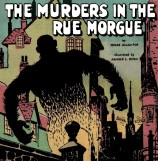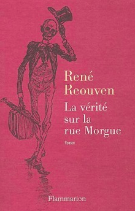Double investigation in the Rue Morgue


In 2004, novelist René Reouven had already proposed a new version of the case, which linked the three investigations carried out by Chevalier Dupin, with one of his relatives, a woman by the name of Aurore Dupin, alias George Sand, as narrator. In the same fashion as our agent Sylvie Triaire, during our 2017 symposium, explained the murky circumstances of Emma Bovary's death about which the writer Philippe Doumenc had lifted the veil in his own way with his 2009 rewriting.
Our honorary member Uri Eisenzweig believes that it is time for detective criticism, through its scientific expertise, to make its contribution to the search for the truth in this particular case.
Report of Constable Uri Eisenzweig for the reopening of the Rue Morgue investigation:
Happy with the existence of this new site, which will contribute, I am sure, to the much-needed regeneration of our reading habits, I appeal to humanity and above all to the logical spirit of its members to join in the below denunciation of one of the most serious miscarriages of justice in literary history. This injustice is all the more unbearable as it taints the founding text of the literary genre that interests us all, "The Murders in the Rue Morgue".
As we know, Chevalier Dupin concludes his investigation by presenting the murder of two women as having been committed by an orangutan escaped from the Parisian apartment where a sailor recently arrived from Borneo had locked him up. However ingenious Dupin's demonstration, however clever it may be, leads to absurdity. This is obvious, or at least it should be, provided one pays attention to the temporality of the events recounted.
1. The murders are committed in the early morning hours of a day which we shall refer to as the "D" day. The text refers to an evening edition of the Gazette des Tribunaux which states "This morning, about three o'clock...".
2. As this is an evening edition, the next issue referred to ("The next issue carried these additional details"), logically dates from the day D + 1.
3. An evening edition then appeared again ("The evening edition of the paper stated that the greatest excitement continued in the Quartier St. Roch”). Having read it, Dupin declares: "We will go and see the premises with our own eyes. I know G..., the Prefect of Police, and shall have no difficulty in obtaining the necessary permission". Dupin having said this in the evening of D + 1, it is thus on D + 2 - at the earliest - that the visit takes place: "The permission was obtained, and we proceeded at once to the Rue Morgue (...) It was late in the afternoon when we reached it". However, lacking basic means of communication such as fax or email (but how did they do it?), the bureaucracy of the time could not be any faster than it is today, which is certainly not insignificant. It is therefore more than likely that this visit actually takes place several days after this "next day". However, let us avoid assumptions: what is certain is that it cannot have taken place before D-Day + 2.
4. It is therefore during D + 3 (at least), from midday onwards that Dupin reveals his cogitations to the narrator: "It was his humour, now, to decline all conversation on the subject of the murder, until about noon the next day".
5. His monologue is so long that it must have been very late in the afternoon when the sailor's visit was interrupted by Dupin's advertisement in a daily newspaper. What follows is announced by the text, according to which the orangutan was subsequently caught by the owner himself". It leads us in the best of cases to D-Day + 4. It is moreover likely that it is much "later" than that. For if Dupin claims to know that the murderer is a monkey, he doesn't say where to find him, and the sailor, who has been looking for him for several days, has no more reason to know after than before his meeting with the detective and his narrator friend. But let's not quibble: luck helping, the sailor will get his animal back on D+4, at the earliest.
This is the nonsense of Dupin’s solution. Indeed this presupposes that in the first decades of the 19th century, in a major European capital, an orangutan could wander (stroll, as the French translator would no doubt have said) through the streets for at least five days without being noticed by anyone.
One could argue that this is one of Poe’s obsessions, thinking of the stolen letter whose presence even blinded him. But it is still a far cry from the thinness of a sheet of paper with the thick build of an orangutan.
Doesn't this one rather make one think of certain contemporary bastards that try to mimic the gestures of human beings, believing that they are forgetting the nothingness that haunts them? Although it is difficult to imagine, at the sight of an orangutan walking down the street in the 19th century, a Parisian blindness as stunning as that of so many Americans today in the face of a rude and bloated President betraying his country under the amused - and televised - eyes of his owner, I mean his sponsor. So much so that one wonders whether there is not a certain uniquely American fascination with what the Baltimore poet so aptly calls the "habit of denying what is and explaining what is not".
Let us return to the horrible double murder on the Rue Morgue. I don't like to admit it, but I don't know who did it. What I do know for certain is that it couldn't have been that poor orangutan. Hence my anguished call: when will a petition demanding his immediate rehabilitation be forthcoming? It would certainly be to the honour of this site, whose raison d'être is in any case confirmed by this evidence: that the first police investigation in literary history was the opportunity for the first Great Detective to make a complete mistake.
Uri Eisenzweig
To cite this article:
Uri Eisenwzeig, « For a reopening of the Rue Morgue affair », Intercripol – Revue de critique policière, « GrandsDossiers : double investigation dans la rue Morgue », N°001, Décembre 2019, URL:
Double solution for double murder (and maybe more...)
A marvel of synchronicity, a solitary investigator and vigilante, William Kels - who has since officially joined the ranks of Intercripol - confirmed our agent's doubts, in an article published a few weeks later, and sought out the assassin by following the trail of the apparently harmless reference to Cuvier's natural history:
In Poe's "The murders in the rue Morgue" the ideal culprit is an orangutan. And perhaps the more ideal he is, the less guilty he is. Of course, what overwhelms the beast is also what rules out incriminating anyone. But the all-mental trial, of which, as a hypothesis, the beast is both a principle and an end, draws on resources whose triviality also has its metaphysical dimension. Read more (in French) on diakritic.com.
The Honourable Detective Kels also makes some useful historiographical remarks, confirming that the presence of an orangutan, as assumed in the story, is highly unlikely. Read “What is an orang-outan worth at the time of Murders in the Rue Morgue”.
At the same time, Caroline Julliot, our great investigator, answered Uri Eisenzweig's call. She slipped into Dupin's skin, in order to adopt his "divinatory" deductive method, to see if the detective could not be caught at his own game:
Thanks to the valuable preliminary investigation of our agent Uri Eisenzweig, it is now established that the solution proposed in this seminal work of the detective genre is highly improbable; all the more so since the objection he expressed on the occasion of the opening of our digital laboratory is only the last and most decisive in a long list of critics who, for more than a century and a half, "combing through the narrative with a fine-tooth comb, examining every articulation", have expressed "serious reservations as to the intrinsic logic of the plot". It is our turn, therefore, to immerse ourselves in "a first-degree reading of the tale," and to try, not only, like our predecessors, to uncover all the inconsistencies, but, above all, to try to explain them, in order to discover the real murderer in the Rue Morgue. Read more here.
A report which did not fail to make Detective Kels react - whose conclusions, divergent from his own, led him to perfect his own:
Dear investigator,
I felt before I read you, and even more so as I progressed in the reading, that you had Dupin in your sights. I had also thought for a moment about incriminating Dupin, but that is where I must, if I may, form an objection - the objection of someone who would be well advised not to incriminate him, since one has to sacrifice to find who has the most to gain from this crime: and that man will be me. Click here to discover the new twists in the investigation.
Two possibilities therefore, at the very least, demonstrating, each in its own way and equally irrefutably, that Dupin invented everything. Perhaps there is a theory that will win everyone's support - Intercripol is listening to any new evidence that could reopen this thorny issue. One thing is certain, in any case, at this stage of the investigation: This poor orangutan is definitely out of the question.
Pending this hypothetical definitive revelation, we consider it equally satisfying to have proposed a double solution for this story of double murder filled with double figures.
Mission accomplished, therefore, according to our honorary member Uri Eisenzweig, who is behind the reopening of this cold case - the first in the history of crime fiction. For the time being, we leave him with the final word on the story...
All of this confirms my position that it is much more epistemologically sound to exonerate than to accuse. That's why I refused to substitute a guilty man for the orangutan. I refuse the idea of a truth that would (only) be narrative, following in this respect that of Bernard Lazare, whom I consider to be a heroic precursor of the intercripolian enterprise (as I conceive it), and who, after having demonstrated the inanity of the story of a guilty Dreyfus, became silent as soon as the fight consisted above all in identifying and charging the real culprit, that is to say, basically, seeing the truth only in another story (one can imagine what separates me from our President, a great admirer of Zola). For me, the beauty of the orangutan of the Rue Morgue is the absence of crime, for want of a criminal. I simply wanted to drive Poe into his predictable - and perhaps, I would not be surprised, consciously planned – corners by eliminating the orangutan as well. Notwithstanding the elegance of Caroline Dupin's argument and Agent Kels' cunning alternative, I stand by my abstention.
Uri Eisenzweig.
To quote this text: Uri Eisenzweig, "Non-conclusion of the investigation", in Intercripol - Revue de critique policière, "Grands dossiers : double investigation dans la rue Morgue", N°001, December 2019.